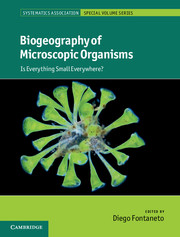Book contents
- Frontmatter
- Contents
- List of contributors
- Preface
- Part I Theoretical framework
- Part II Prokaryotes
- 3 Biogeography of prokaryotes
- 4 Thermophilic bacteria in cool soils: metabolic activity and mechanisms of dispersal
- Part III Unicellular eukaryotes
- Part IV Pluricellular eukaryotes
- Part V Processes
- Index
- Systematics Association Publications
- Systematics Association Special Volumes
- Plate section
- References
3 - Biogeography of prokaryotes
from Part II - Prokaryotes
Published online by Cambridge University Press: 05 August 2012
- Frontmatter
- Contents
- List of contributors
- Preface
- Part I Theoretical framework
- Part II Prokaryotes
- 3 Biogeography of prokaryotes
- 4 Thermophilic bacteria in cool soils: metabolic activity and mechanisms of dispersal
- Part III Unicellular eukaryotes
- Part IV Pluricellular eukaryotes
- Part V Processes
- Index
- Systematics Association Publications
- Systematics Association Special Volumes
- Plate section
- References
Summary
Introduction
Prokaryotic microorganisms are critical to terrestrial and aquatic ecosystem function due to their involvement in key biogeochemical processes and interaction with macroorganisms (Bell et al., 2005a). The Bacteria are assumed to occur ubiquitously as a result of their large population sizes, rapid generation times and high dispersal rates. Increasingly the Archaea are also being recognised as key components of many biomes (Auguet et al., 2010). The long-held tenet in microbiology that ‘everything is everywhere, the environment selects’ (Baas Becking, 1934) has been employed as a de facto null hypothesis against which to test the existence of spatio-temporal patterns in prokaryotic distribution. Demonstrating the existence of such patterns and their underlying drivers is key to understanding microbial biogeography. This has wide-reaching implications for understanding ecosystem function, conservation value for microorganisms and bioprospecting for strains with biotechnology potential (Prosser et al., 2007).
The prokaryotic species concept
A major limitation to the elucidation of prokaryotic biogeography lies with the species concept as applied to prokaryotes. It is necessary to be able to recognise the diversity of species in community-level studies, and also the abundance of a given species in population studies. The traditional view of a species as a group of individuals that interbreed and are isolated from other species by barriers to recombination (Mayr, 1957) is generally assumed not to be applicable to the asexual lifestyle of prokaryotes, although it is emerging that recombinant events may be more widespread than earlier assumed for some microorganisms (Fraser et al., 2007).
- Type
- Chapter
- Information
- Biogeography of Microscopic OrganismsIs Everything Small Everywhere?, pp. 35 - 42Publisher: Cambridge University PressPrint publication year: 2011
References
- 3
- Cited by

